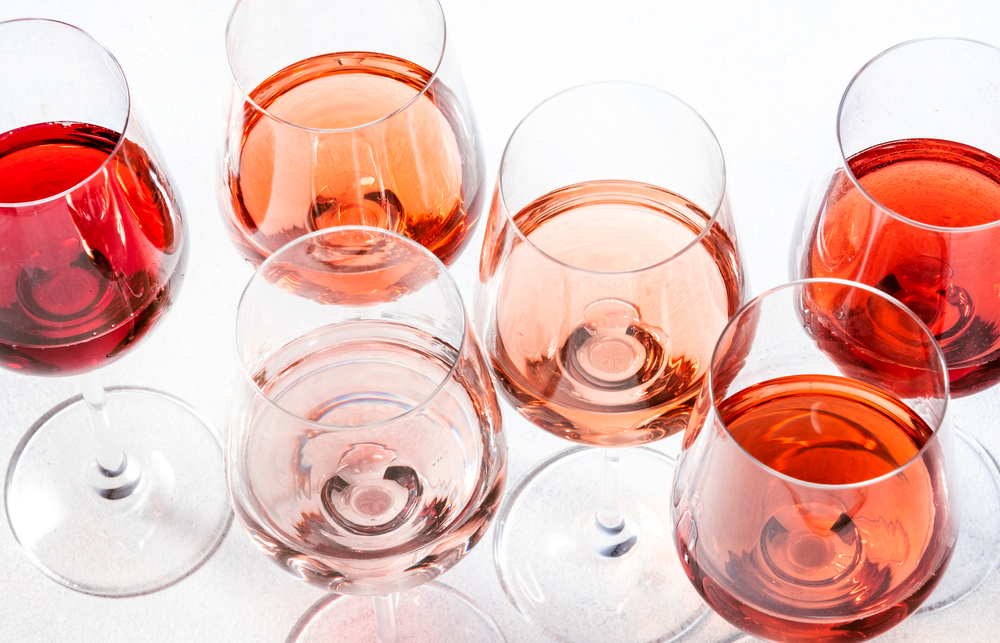Rosé has exploded in the U.S. the past few years, and for good reason. The delicate flavorings bring taste buds to life, which is why more and more people are scouring the shelves for more rosé.
Red, white, blush—the trio of the styles of wine that have had people embracing love and life for centuries. The consumption of rosé has been on the rise since 1990. Today, “one in three bottles of wine purchased is a bottle of rosé,” according to the Council of the Wines of Provence.
As you’re searching to find the best rosé for spring occasions, you’ll need to know what exactly rosé is and how people create it. We’ve provided a comprehensive guide to rosé wine so that you can get to sipping, enjoying, and living!
How Rosé Is Made
When learning about rosé, it’s important to understand the process of creating wine color in general. There are two different processes that tend to create rosé wines:
Maceration
The way that wines receive their color is from the clear juice’s contact with the skin of the grapes. As those sit with each other—think of it as a margination—the skin color bleeds into the juice, giving the wine its red or yellow color. This process is called maceration.
Many make rosés via the maceration process. Whereas red grape skins may soak in the juice for weeks or months at a time for red wine, the process is much shorter for rosé wine. Winemakers will create the wine by juicing red grapes and allowing the juice to soak with the skins for a very short period of time—about two or three days.
As the juice takes on the color we all know and love, the skins are removed, and the fermentation process begins.
Saignée Method
This method of creating rosé comes from the direct-press of the grapes. Basically, this process involves “bleeding off” a portion of red wine juice after it has been in contact with the skins. Saignée-made rosé wines are going to be darker and stronger than a maceration-made rosé.
Old World v. New World Rosé
 When it comes to picking out the perfect wine for your taste buds, you’ll want to think about the regionality of the wine. After all, the same type of wine can have different tastes depending on where it’s from. Knowing where the rosé comes from and what types of grapes are used to make it will help you make a more informed decision about the wine to buy. This is where the old and new world come into play.
When it comes to picking out the perfect wine for your taste buds, you’ll want to think about the regionality of the wine. After all, the same type of wine can have different tastes depending on where it’s from. Knowing where the rosé comes from and what types of grapes are used to make it will help you make a more informed decision about the wine to buy. This is where the old and new world come into play.
Old World
Old World wines come from grapes grown on incredibly old (think centuries) vines in Europe. The mature vines create an earthier and more acidic wine. Provence, France, is the rosé capital of the world—the area has been making wine for centuries. The soil and moderate climate make for delicious wines. Therefore, the old world Provence rosé is a perfect choice for drinking.
New World
New World wines are those produced outside of the traditional wine growing areas of Europe. Think California, Oregon, New Zealand, and Chile. Oregon is a great wine country—sharing the same latitudinal gradient as growing regions in Southern France, winemakers get the same moderate climate.
10 Heavenly Styles of Rosé Wine
1. Pinot Noir Rosé
Pinot Noir grapes are full of qualifications—they do not fare well under extreme weather conditions. But when winemakers do it well, Pinot Noir gives a bright acidity complemented by subtle aromas of watermelon, strawberries, and crabapple. You’ll love the delicately fruity rosé for its elegant and subtle flavorings. Keep in mind, fruity does not necessarily mean sweet.
Pairs well with:
Light seafood options or fresh vegetable and goat cheese salads.
2. Syrah Rosé
Syrah rosés are full of rich flavor and an oily texture—this is a unique and intense rosé. The full-bodied wines ooze cherry flavors, red pepper flake, and have a hint of bitter lime zest. If you’re looking for a fruity rosé, this is not what you want to grab from the shelves.
Pairs well with:
Italian inspired foods, such as a light pepperoni pizza or lemon-garlic shrimp and paella.
3. Tempranillo Rosé
This style of rosé is gaining popularity from various regions in Spain. The pale pink color draws you in as the savory and fruity components of the wine keep you coming back for more. The herbaceous notes of grilled chicken and green peppercorns pair delightfully well with the watermelon and raspberry notes.
Pairs well with:
Spanish cuisine or barbeque grilled meats.
4. Provence Rosé
As previously stated, rosé from Provence is some of the best you can get. You can drink this Provence style wine anywhere, whether it’s in the backyard or at a formal wedding. The crisp and fresh wine makes it extremely versatile and its notes of rose petal pair well with the salty minerality left in your mouth.
Pairs well with:
Almost anything—from seafood to veal to French toast.
5. Tavel Rosé
Another dry rosé, Tavel has more structure and body than other pink wines. It has all of the wonderful characteristics of red wine—it just lacks the bold coloring. Typically, low in acidity but high in alcohol, Tavel offers nutty notes that intensify the summer berry richness of the wine.
Pairs well with:
Barbequed meats such as brisket or meat-filled charcuterie board.
6. Mourvèdre Rosé
You’ll notice these wines by their pale coral hue. The floral notes perfectly bring out the violets and rose petals which accentuate the red plums and cherries. Better yet, you’ll also notice dried herbs and a bit of smoke. This fruity and floral wine is round and full-bodied.
Pairs well with:
Mediterranean meals—grilled lamb with fresh pita bread.
7. Cabernet Sauvignon Rosé
Made exclusively by the Saignée method, Cabernet rosés are a deep ruby red color with flavors similar to red wine. The main difference between the rosé and the red wine is the heightened acidity you’ll find in the rosé. The concentrated cherry notes mesh well with the black pepper.
Pairs well with:
Beef and lamb dishes.
8. Sangiovese Rosé
The notes of green melon, yellow peach, and roses are what make Sangiovese rosés such an incredible wine to sip. The bright copper red color shimmers in the light and is perfect for a summer day.
Pairs well with:
Chicken and various other Mediterranean inspired dishes.
9. Grenache Rosé
One of the fruitiest rosés, Grenache has the perfect levels of tannins and acidity. Best served cold, you’ll admire the subtle notes of orange and hibiscus that perfectly complement the ripe strawberries.
Pairs well with:
Creamy Mediterranean and light Italian dishes.
10. Zinfandel Rosé
The rosé that tainted the complexity of other rosés, Zinfandel rosé wines are going to be sweet as can be. The candied strawberry tastes mesh well with the cotton candy, lemon, and green melon notes.
Pairs well with:
Zesty Thai cuisine.
Our guide to rosé wine is complete! Remember that whichever rosé wine style you decide to go for, we’ll have it all here at our online wine shop throughout the spring. In addition to some of the best rosés available now, we always carry high-quality white wines and top-rated red wines to serve as the perfect sippers for the season.




